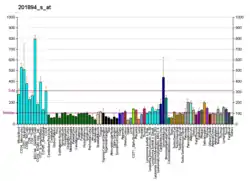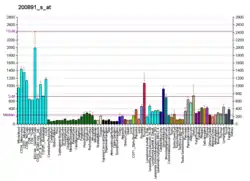SSR1
Translocon-associated protein subunit alpha is a protein that in humans is encoded by the SSR1 gene.[5]
| SSR1 | |||||||||||||||||||||||||
|---|---|---|---|---|---|---|---|---|---|---|---|---|---|---|---|---|---|---|---|---|---|---|---|---|---|
| Identifiers | |||||||||||||||||||||||||
| Aliases | SSR1, TRAPA, signal sequence receptor subunit 1 | ||||||||||||||||||||||||
| External IDs | OMIM: 600868 MGI: 105082 HomoloGene: 2368 GeneCards: SSR1 | ||||||||||||||||||||||||
| |||||||||||||||||||||||||
| |||||||||||||||||||||||||
| |||||||||||||||||||||||||
| |||||||||||||||||||||||||
| Orthologs | |||||||||||||||||||||||||
| Species | Human | Mouse | |||||||||||||||||||||||
| Entrez | |||||||||||||||||||||||||
| Ensembl | |||||||||||||||||||||||||
| UniProt | |||||||||||||||||||||||||
| RefSeq (mRNA) | |||||||||||||||||||||||||
| RefSeq (protein) | |||||||||||||||||||||||||
| Location (UCSC) | Chr 6: 7.27 – 7.35 Mb | Chr 13: 37.97 – 37.99 Mb | |||||||||||||||||||||||
| PubMed search | [3] | [4] | |||||||||||||||||||||||
| Wikidata | |||||||||||||||||||||||||
| |||||||||||||||||||||||||
The signal sequence receptor (SSR) is a glycosylated endoplasmic reticulum (ER) membrane receptor associated with protein translocation across the ER membrane. The SSR consists of 2 subunits, a 34-kD glycoprotein encoded by this gene and a 22-kD glycoprotein. This gene generates several mRNA species as a result of complex alternative polyadenylation. This gene is unusual in that it utilizes arrays of polyA signal sequences that are exclusively non-canonical.[5]
References
- GRCh38: Ensembl release 89: ENSG00000124783 - Ensembl, May 2017
- GRCm38: Ensembl release 89: ENSMUSG00000021427 - Ensembl, May 2017
- "Human PubMed Reference:". National Center for Biotechnology Information, U.S. National Library of Medicine.
- "Mouse PubMed Reference:". National Center for Biotechnology Information, U.S. National Library of Medicine.
- "Entrez Gene: SSR1 signal sequence receptor, alpha (translocon-associated protein alpha)".
Further reading
- Wei ML, Cresswell P (1992). "HLA-A2 molecules in an antigen-processing mutant cell contain signal sequence-derived peptides". Nature. 356 (6368): 443–6. Bibcode:1992Natur.356..443W. doi:10.1038/356443a0. PMID 1557127. S2CID 4310708.
- Vogel F, Hartmann E, Görlich D, Rapoport TA (1991). "Segregation of the signal sequence receptor protein in the rough endoplasmic reticulum membrane". Eur. J. Cell Biol. 53 (2): 197–202. PMID 1964414.
- Hartmann E, Görlich D, Kostka S, et al. (1993). "A tetrameric complex of membrane proteins in the endoplasmic reticulum" (PDF). Eur. J. Biochem. 214 (2): 375–81. doi:10.1111/j.1432-1033.1993.tb17933.x. hdl:11858/00-001M-0000-0015-3BD2-F. PMID 7916687.
- Hartmann E, Prehn S (1994). "The N-terminal region of the alpha-subunit of the TRAP complex has a conserved cluster of negative charges". FEBS Lett. 349 (3): 324–6. doi:10.1016/0014-5793(94)00693-8. PMID 8050590. S2CID 42968119.
- Maruyama K, Sugano S (1994). "Oligo-capping: a simple method to replace the cap structure of eukaryotic mRNAs with oligoribonucleotides". Gene. 138 (1–2): 171–4. doi:10.1016/0378-1119(94)90802-8. PMID 8125298.
- Hu T, Guan T, Gerace L (1996). "Molecular and functional characterization of the p62 complex, an assembly of nuclear pore complex glycoproteins". J. Cell Biol. 134 (3): 589–601. doi:10.1083/jcb.134.3.589. PMC 2120945. PMID 8707840.
- Suzuki Y, Yoshitomo-Nakagawa K, Maruyama K, et al. (1997). "Construction and characterization of a full length-enriched and a 5'-end-enriched cDNA library". Gene. 200 (1–2): 149–56. doi:10.1016/S0378-1119(97)00411-3. PMID 9373149.
- Hirama T, Miller CW, Koeffler HP (1999). "Translocon-associated protein alpha transcripts are induced by granulocyte-macrophage colony-stimulating factor and exhibit complex alternative polyadenylation". FEBS Lett. 455 (3): 223–7. doi:10.1016/S0014-5793(99)00885-6. PMID 10437777. S2CID 9426244.
- Wang L, Dobberstein B (1999). "Oligomeric complexes involved in translocation of proteins across the membrane of the endoplasmic reticulum". FEBS Lett. 457 (3): 316–22. doi:10.1016/S0014-5793(99)01075-3. PMID 10471800. S2CID 22341517.
- Strausberg RL, Feingold EA, Grouse LH, et al. (2003). "Generation and initial analysis of more than 15,000 full-length human and mouse cDNA sequences". Proc. Natl. Acad. Sci. U.S.A. 99 (26): 16899–903. doi:10.1073/pnas.242603899. PMC 139241. PMID 12477932.
- Zhang H, Li XJ, Martin DB, Aebersold R (2003). "Identification and quantification of N-linked glycoproteins using hydrazide chemistry, stable isotope labeling and mass spectrometry". Nat. Biotechnol. 21 (6): 660–6. doi:10.1038/nbt827. PMID 12754519. S2CID 581283.
- Mungall AJ, Palmer SA, Sims SK, et al. (2003). "The DNA sequence and analysis of human chromosome 6". Nature. 425 (6960): 805–11. Bibcode:2003Natur.425..805M. doi:10.1038/nature02055. PMID 14574404.
- Gerhard DS, Wagner L, Feingold EA, et al. (2004). "The status, quality, and expansion of the NIH full-length cDNA project: the Mammalian Gene Collection (MGC)". Genome Res. 14 (10B): 2121–7. doi:10.1101/gr.2596504. PMC 528928. PMID 15489334.
- Stelzl U, Worm U, Lalowski M, et al. (2005). "A human protein-protein interaction network: a resource for annotating the proteome". Cell. 122 (6): 957–68. doi:10.1016/j.cell.2005.08.029. hdl:11858/00-001M-0000-0010-8592-0. PMID 16169070. S2CID 8235923.
- Otsuki T, Ota T, Nishikawa T, et al. (2007). "Signal sequence and keyword trap in silico for selection of full-length human cDNAs encoding secretion or membrane proteins from oligo-capped cDNA libraries". DNA Res. 12 (2): 117–26. doi:10.1093/dnares/12.2.117. PMID 16303743.
- Olsen JV, Blagoev B, Gnad F, et al. (2006). "Global, in vivo, and site-specific phosphorylation dynamics in signaling networks". Cell. 127 (3): 635–48. doi:10.1016/j.cell.2006.09.026. PMID 17081983. S2CID 7827573.
This article is issued from Wikipedia. The text is licensed under Creative Commons - Attribution - Sharealike. Additional terms may apply for the media files.






